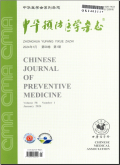上海市婴幼儿胎儿期重金属暴露水平及危险因素
Exposure level and risk factors of heavy metal in prenatal period among Shanghai infants
摘要目的 探讨上海市婴幼儿胎儿期重金属暴露水平及其影响因素。方法 通过分层整群抽样方法调查2008年10月至2009年10月期间在上海市10家有助产资格的医院分娩的孕产妇,共1652名。对研究对象进行问卷调查,检测脐带全血中铅、汞含量(中位数),血清中锰、镉、砷、铊含量(中位数),用单因素、多元线性回归方法分析其暴露危险因素。结果 脐带全血铅、汞,血清锰、镉、砷、铊含量中位数分别为41.00、1.88、4.10、0.03、0.86、0.02 μg/L。孕期每周食海鱼频率为4~7次者[9.7%( 160/1652)]血汞含量(2.76 μg/L)高于每周1~3次者[49.3%( 814/1652),2.41 μg/L]和很少食用者[40.0% (661/1652),2.03μg/L],差异有统计学意义(x2=36.40,P<0.001);家中用PVC管者[85.0%( 1404/1652)]脐血铅、铊含量高于用镀锌管者[15.0%(248/1652)](铅:45.54、40.00 μg/L,Z=2.54,P<0.05;铊:0.021、0.018 μg/L,Z=2.97,P<0.05),而脐血砷含量低于用镀锌管者(4.33、9.37 μg/L),差异有统计学意义(Z=3.99,P<0.01);近3年家中有装修史者[38.0% (628/1652)],脐血锰、镉、铊含量高于未装修者[62.0% (1024/1652)],差异有统计学意义(锰:14.78、11.01 μg/L,Z=2.46,P<0.05;镉:0.51、0.29 μg/L,Z=2.38,P<0.05;铊:0.022、0.02μg/L,Z=2.81,P<0.01)。结论 上海市婴幼儿在胎儿期存在重金属暴露.饮食及装修污染是脐血中重金属的重要来源。
更多相关知识
abstractsObjective To explore the exposure level and risk factors of heavy metal among Shanghai infants in their prenatal period. Methods A total of 1652 pregnant or puerperal women were recruited from 10 midwifery-qualified hospitals in Shanghai since October 2008 to October 2009, by the stratified cluster sampling method. They answered the questionnaire and their umbilical cord blood and serum were collected to detect the content of Pb, Hg, Mn, Cd, As and Tl. The risk factors were analyzed by single and multiple regression methods respectively. Results The median value of the content of Pb, Hg, Mn, Cd, As and Tl were 41.00,1.88,4.10,0.03,0.86 and 0.02 μg/L respectively. The Hg concentration of pregnant women who ate fish for 4 -7 times per week (9.7% (160/1652) ) was 2.76 μg/L,which was higher than that of pregnant women who only ate fish for 1 -3 times per week (49.3% (814/1652)) and those who seldom ate fish (40.0% (661/1652)); the Hg concentration in the two groups above were 2.41 and 2.03 μg/L separately. The difference had statistical significance (x2= 36.40, P< 0.001 ) .Meanwhile, the concentrations of Pb and Tl in the group of pregnant women whose houses were remodeled by PVC pipe (85.0% (1404/1652) ) was higher than the concentrations in group of pregnant women whose houses were remodeled by galvanized pipe (15.0% (248/1652)); the Pb concentration in the two groups above were 45.54 and 40.00 μg/L( Z =2.54 ,P < 0.05 ) and the Tl concentration in the two groups above were 0.021 and 0.018 μg/L(Z = 2.97, P < 0.05 ). However, the As concentration in the group of PVC pipe remodeled was 4.33 μg/L,which was lower than that in the group of galvanized pipe (9.37 μg/L). The difference had statistical significance( Z = 3.99, P < 0.01 ). The concentrations of Mn, Cd and Tl in the groups of pregnant women whose house had been remodeled in the last 3 years (38.0% (628/1652)) were 14.78,0.51 and 0.022 μg/L separately,which were all significantly higher than those in the groups of women whose houses' were not remodeled (62.0% ( 1024/1652 ) ), whose concentrations were 11.01,0. 29 and 0.02 μg/Lrespectively. The differences had statistical significance ( Mn∶Z = 2.46, P < 0.05 ; Cd : Z = 2.38, P < 0.05 ;Tl∶Z =2.81, P < 0.01 ). ConclusionThe infants in Shanghai were exposed to heavy metals in their prenatal period. The main sources of the exposure were daily diet and remodeled pollution.
More相关知识
- 浏览520
- 被引10
- 下载124


相似文献
- 中文期刊
- 外文期刊
- 学位论文
- 会议论文



 换一批
换一批 换一批
换一批



